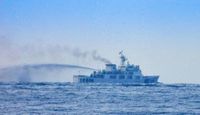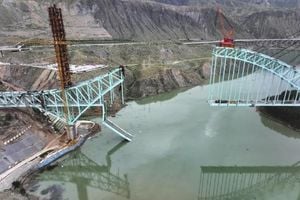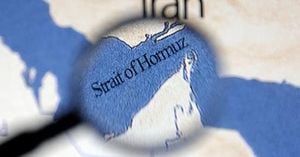In a dramatic escalation of tensions in the South China Sea, the Philippines has condemned what it calls a "swarm" of Chinese armed coast guard and maritime militia vessels that have converged near the Second Thomas Shoal, a fiercely contested atoll in the Spratly Islands. The deployment, which began on August 20, 2025, and has persisted through the week, has been described by Philippine officials as one of the most aggressive Chinese shows of force in recent years, raising the specter of a broader regional confrontation.
The Second Thomas Shoal—known locally as Ayungin Shoal and referred to by China as Ren’ai Reef—has long been a flashpoint in the South China Sea dispute. The Philippines maintains a small military outpost there aboard the BRP Sierra Madre, a rusting World War II-era warship deliberately grounded in 1999 to assert Manila’s territorial claims. According to the Associated Press, this outpost has become the focal point for repeated, tense faceoffs between Filipino and Chinese forces.
On August 22, Philippine Defense Secretary Gilberto Teodoro publicly denounced China’s latest deployment, which included several coast guard cutters, nine maritime militia vessels, numerous speedboats fitted with high-caliber machine guns, and aerial support from a helicopter and a drone. “China’s actions and its nebulous territorial claims in the disputed waters are a matter not only of concern, but of condemnation because these are gross violations of international law,” Teodoro said at a joint news conference with visiting Australian Defense Minister Richard Marles, as reported by AP.
Teodoro’s remarks came after closed-door talks with Marles, who reaffirmed Australia’s support for the Philippines and the broader rules-based order in the region. “We work really closely with the Philippines in terms of asserting the rules-based order in the South China Sea,” Marles stated. “That’s really important for us to jointly do. We understand that in that work, there will be an interaction between defense forces.”
The Philippine military reported that a Chinese boat came as close as 50 meters (164 feet) to the Sierra Madre, prompting Filipino forces to deploy two boatloads of personnel to block any further approach. General Romero Brawner Jr., the Philippine military chief, described the situation as "tense," noting, “They’re trying to get closer but our troops continue to push them outward.”
This surge in Chinese maritime activity comes on the heels of an incident at Scarborough Shoal, another disputed area, where on August 11 a Chinese navy destroyer and a coast guard ship collided while attempting to block a Philippine cutter. The crash caused significant damage to the Chinese coast guard vessel and may have resulted in injuries or crew members being thrown overboard, according to video evidence cited by Philippine officials. Chinese authorities have not commented on the incident.
China’s coast guard, meanwhile, has accused the Philippines of "staged provocations." In a statement released on August 22, Chinese spokesperson Gan Yu urged the Philippines to “immediately stop all infringement activities, provocations and false accusations,” vowing to carry out law enforcement activities in the contested waters. Beijing also released video footage purporting to show Philippine boats approaching Chinese vessels in what it described as “an unprofessional and dangerous manner.” The footage, as reviewed by AP, showed two small boats approaching a Chinese ship, with one person appearing to hold a camera and the other boat keeping some distance.
Rear Admiral Roy Vincent Trinidad of the Philippine Navy highlighted the unusual nature of the Chinese deployment, pointing out the display of heavy weaponry and the use of nets to obstruct navigation. Footage from the Philippine Coast Guard showed Chinese vessels engaging in maneuvers, practicing with water cannons, and deploying obstacles aimed at impeding maritime traffic. “This is not typical behavior,” Trinidad noted, emphasizing the heightened risk of escalation.
The Second Thomas Shoal is part of the broader Spratly Islands chain, a region claimed in whole or in part by the Philippines, China, Vietnam, Taiwan, Malaysia, and Brunei. The area is not only strategically significant for its location along key global shipping routes but is also believed to be rich in resources. Since early 2023, Filipino resupply missions to the Sierra Madre have faced increasingly aggressive Chinese actions, including collisions and water cannon attacks. Tensions appeared to ease somewhat after a June 2024 incident in which several Philippine sailors were injured, but the recent surge in Chinese presence has reignited fears of a wider conflict.
Analysts cited by AP and regional media suggest that the uptick in Chinese maritime operations may be a direct response to the Scarborough Shoal collision, with Beijing seeking to reassert its strength both to domestic audiences and to regional rivals. The question now, experts say, is whether China will maintain this heightened presence or escalate further by directly confronting future Philippine resupply missions to the Sierra Madre—a move that could have significant implications for regional stability and potentially draw in the United States under its mutual defense treaty with the Philippines.
Amid these rising tensions, Australia and the Philippines have launched their largest-ever joint military exercises, code-named Alon (Tagalog for “wave”). The drills, involving more than 3,600 military personnel, feature live-fire exercises, a mock amphibious beach assault, and the participation of an Australian guided-missile destroyer, F/A-18 supersonic fighter jets, a C-130 cargo aircraft, Javelin anti-tank weapons, and special forces sniper teams. According to Philippine defense officials, the exercises are designed to enhance "interoperability, collective deterrence and long-term military readiness ... to promote regional security and stability." Marles was invited to observe the drills over the weekend of August 23-24, underscoring Australia’s growing role as a regional security partner.
China has voiced alarm over these joint exercises, which it views as a challenge to its sweeping claims over nearly the entire South China Sea. In recent years, Chinese military and coast guard vessels have confronted U.S., Australian, and Philippine ships and aircraft in increasingly close encounters, raising concerns of an accidental clash that could spiral into a larger conflict.
For now, the situation at Second Thomas Shoal remains on a knife’s edge. Filipino troops continue to hold their position aboard the battered Sierra Madre, while Chinese vessels maintain their watchful presence nearby. With diplomatic efforts ongoing but tensions still simmering, the coming weeks could prove pivotal for the future of the South China Sea—and for the balance of power in the Asia-Pacific region.






